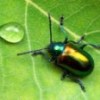
Forget the heavy pro-grade camera gear for a moment. This shot was taken with a $300 Panasonic Lumix DMC-ZS3 digicam. These small cameras do wide-angle macro exceptionally well, and their tiny sensors and lenses give them a small-world perspective that SLR cameras struggle to replicate. Here, I placed the camera on the ground underneath a foot-high canopy of mayapples.
More like this
The person who never seems to be able to operate, or be happy with, these modern digital cameras.
Just to be clear, Newton probably didn't have a portable video camera. I do. I have one of these Flip Mino pocket cameras. Very nice. You can put it in your pocket. However, there is a problem with cameras like these (think of video from camera phones).
[Originally posted in January 2008]
When we watch a movie, we're usually not consciou

Great Pics!! I wanted to be an entomologist and am still engrossed with insects. I just got a camera also, for birds. I tried to take a picture of a beautiful orange jumping spider who was sitting on the top of a Civil War gravestone, but it did not come out well.
I just really wanted to say that I can't believe that your May Apples are up already, next thing you will be shooting Morels...lol. I am sending your link to a photographer friend of mine. He said that Micro is his next project. Thanks
That's a pretty spectacular image, Alex.
Have you posted macro images from this camera on your blog before? If so, which one(s)?
Not going to lie, I had to look twice at the image! I had originally thought it was from the tropics and those were Cercropia trees! Very cool way to bring the tropics home with you!
I've not posted much at all about the Panasonic- I think this is the first one. It's a great little camera, particularly in that it maintains decent optics over an enormous range from wide-angle to long telephoto. It suffers from the usual problems of digicams- shutter lag, low dynamic range, and noisy images. But one can't complain for the price.
For non-professional work I like having a camera that fits in my pocket- a welcome relief after lugging the usual 10 pounds of SLR gear about.
I second Alex's comment about keeping a pocket camera handy - I still bring mine along even though I'm now doing the whole SLR shebang.
Admit it though - the success of this photo owes as much to the photographer's eye as most of the others posted on this blog. The perspective, the thought given to lighting - this was no accident!
School children who see these (Berberidaceae: Podophyllun peltatum) at the nature reserve often call these "umbrella trees", and this persective gives insight into the coining of that name.
BTW, there is a moth whose wings closely match the color and sheen of this plant's flower. The moth roosts - you guessed it - in said flowers. I know nothing more about its life history. Anyone?